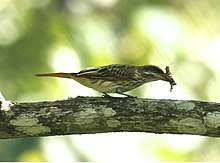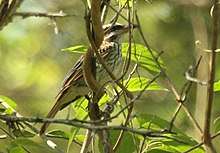Streaked flycatcher
The streaked flycatcher (Myiodynastes maculatus) is a passerine bird in the tyrant flycatcher family.
| Streaked flycatcher | |
|---|---|
.jpg) | |
| In Sarutaiá (São Paulo state, Brazil) | |
| Scientific classification | |
| Kingdom: | Animalia |
| Phylum: | Chordata |
| Class: | Aves |
| Order: | Passeriformes |
| Family: | Tyrannidae |
| Genus: | Myiodynastes |
| Species: | M. maculatus |
| Binomial name | |
| Myiodynastes maculatus (Statius Muller, 1776) | |
Description
The streaked flycatcher is 22 cm (8.7 in) long, weighs 43 g (1.5 oz) and has a strong black bill. The head is brown with a concealed yellow crown patch, white supercilium and dusky eye mask. The upperparts are brown with darker brown streaks on the back, rufous and white edges on the wings, and wide chestnut edges on the rump and tail. The underparts are yellowish-white streaked with brown.


Sexes are similar, but immature birds are brown where the adult is black. M. m. solitarius has black rather than brown streaking above and below. The streaked flycatcher is a conspicuous bird, with a noisy sqEEE-zip call.
It is very similar in appearance to the less widespread sulphur-bellied flycatcher. The streaked flycatcher has a heavier bill, lighter yellow belly, pink basal half of the lower mandible and creamy (not white) superciliary.[2]
Distribution and habitat
This species breeds from eastern Mexico, Trinidad and Tobago south to Bolivia and Argentina. The southern subspecies M. m. solitarius migrates to Venezuela and the Guianas from March to September during the austral winter. It is found at the edges of forests and cocoa plantations. Common across its wide range, this species is not considered threatened by the IUCN.[1]
Behaviour
Feeding
Streaked flycatchers eat a range of food items, mostly large insects, but also lizards and berries. It perches on a high watchpoint from which it sallies forth to catch insects in mid-flight or off plants using a range of aerobatic maneuvers, and occasionally gleans prey from the vegetation.[3] The wintering southern migrants seem to include a considerable amount of fruit in their diet, for example those of Tamanqueiro (Alchornea glandulosa) which they sometimes eat in quantity; fruit are typically ripped off in mid-hover.[4] It occasionally follows mixed-species feeding flocks, pouncing from up in the trees on prey flushed by birds in the undergrowth.[5]
Breeding
The nest is an open cup of twigs and grasses placed in a tree hollow or sometimes a bromeliad. The female builds the nest and incubates the typical clutch of two or three creamy-white eggs, which are marked with red-brown spots, for 16–17 days to hatching. Both sexes feed the chicks, which fledge in a further 18–21 days.
References
- BirdLife International (2012). "Myiodynastes maculatus". IUCN Red List of Threatened Species. 2012. Retrieved 26 November 2013.CS1 maint: ref=harv (link)
- Garrigues, Richard; Dean, Robert (2007). The Birds of Costa Rica. Ithaca: Zona Tropical/Comstock/Cornell University Press. p. 212. ISBN 978-0-8014-7373-9.
- de A. Gabriel, Vagner; Pizo, Marco A. (2005). "Foraging behavior of tyrant flycatchers (Aves, Tyrannidae) in Brazil" (PDF). Revista Brasileira de Zoologia (in English and Portuguese). 22 (4): 1072–1077. doi:10.1590/S0101-81752005000400036.
- Pascotto, Márcia Cristina (2006). "Avifauna dispersora de sementes de Alchornea glandulosa (Euphorbiaceae) em uma área de mata ciliar no estado de São Paulo" [Seed dispersal of Alchornea glandulosa (Euphorbiaceae) by birds in a gallery forest in São Paulo, southeastern Brazil] (PDF). Revista Brasileira de Ornitologia (in Portuguese and English). 14 (3): 291–296. Archived from the original (PDF) on 2010-11-02.
- Machado, C.G. (1999). "A composição dos bandos mistos de aves na Mata Atlântica da Serra de Paranapiacaba, no sudeste brasileiro" [Mixed flocks of birds in Atlantic Rain Forest in Serra de Paranapiacaba, southeastern Brazil] (PDF). Revista Brasileira de Biologia (in Portuguese and English). 59 (1): 75–85. doi:10.1590/S0034-71081999000100010.
- ffrench, Richard; O'Neill, John Patton; Eckelberry, Don R. (1991). A Guide to the Birds of Trinidad and Tobago (2nd ed.). Ithaca, N.Y.: Comstock Publishing. ISBN 0-8014-9792-2.
- Hilty, Steven L. (2003). Birds of Venezuela. Princeton University Press. ISBN 0-7136-6418-5.
External links
| Wikimedia Commons has media related to Myiodynastes maculatus. |
| Wikispecies has information related to Myiodynastes maculatus |
- "Streaked flycatcher media". Internet Bird Collection.
- Streaked flycatcher photo gallery at VIREO (Drexel University)
- Streaked flycatcher Photo at Robert Scanlon's "Birds of Panama" gallery
- Streaked flycatcher species account at Neotropical Birds (Cornell Lab of Ornithology)
- Interactive range map of Myiodynastes maculatus at IUCN Red List maps
